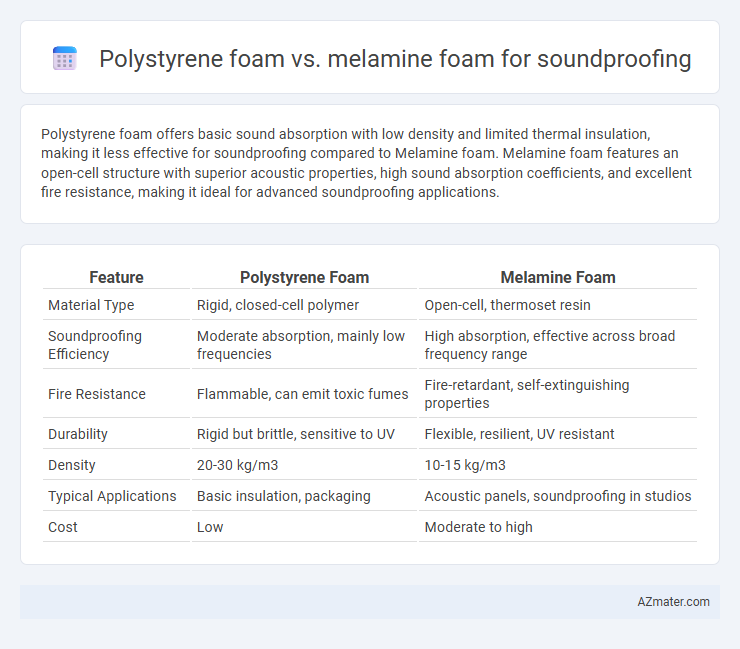Polystyrene foam offers basic sound absorption with low density and limited thermal insulation, making it less effective for soundproofing compared to Melamine foam. Melamine foam features an open-cell structure with superior acoustic properties, high sound absorption coefficients, and excellent fire resistance, making it ideal for advanced soundproofing applications.
Table of Comparison
| Feature | Polystyrene Foam | Melamine Foam |
|---|---|---|
| Material Type | Rigid, closed-cell polymer | Open-cell, thermoset resin |
| Soundproofing Efficiency | Moderate absorption, mainly low frequencies | High absorption, effective across broad frequency range |
| Fire Resistance | Flammable, can emit toxic fumes | Fire-retardant, self-extinguishing properties |
| Durability | Rigid but brittle, sensitive to UV | Flexible, resilient, UV resistant |
| Density | 20-30 kg/m3 | 10-15 kg/m3 |
| Typical Applications | Basic insulation, packaging | Acoustic panels, soundproofing in studios |
| Cost | Low | Moderate to high |
Introduction to Soundproofing Materials
Polystyrene foam and melamine foam are widely used soundproofing materials with distinct acoustic properties. Polystyrene foam, known for its rigidity and low density, primarily reduces airborne noise by reflecting sound waves, making it effective in insulation applications. Melamine foam excels in absorbing mid to high-frequency sounds due to its open-cell structure and high porosity, which enhances sound diffusion and attenuation in environments requiring noise control.
What is Polystyrene Foam?
Polystyrene foam, commonly known as expanded polystyrene (EPS), is a lightweight, rigid foam widely used for insulation and soundproofing due to its closed-cell structure that provides effective noise reduction and thermal insulation. Its dense composition makes it suitable for blocking airborne sound, although it is less effective at absorbing sound compared to open-cell materials like melamine foam. Polystyrene foam's affordability and moisture resistance contribute to its popularity in construction and soundproofing applications.
What is Melamine Foam?
Melamine foam is a lightweight, open-cell material known for its excellent sound absorption and thermal insulation properties, commonly used in soundproofing applications. Unlike polystyrene foam, which primarily provides thermal insulation with limited acoustic benefits, melamine foam effectively reduces noise by trapping sound waves within its porous structure. Its fire-resistant and environmentally friendly characteristics make melamine foam a preferred choice for acoustic panels, studios, and real estate soundproofing solutions.
Acoustic Performance: Polystyrene Foam vs Melamine Foam
Melamine foam outperforms polystyrene foam in soundproofing due to its open-cell structure, which effectively absorbs a broad range of sound frequencies and reduces reverberation. Polystyrene foam, being a closed-cell material, primarily offers thermal insulation and has limited sound absorption capabilities, making it less efficient for acoustic dampening. When targeting noise reduction and improved acoustic performance, melamine foam is the preferred choice for soundproofing applications.
Noise Reduction Coefficient (NRC) Comparison
Polystyrene foam typically has a lower Noise Reduction Coefficient (NRC) ranging from 0.10 to 0.25, making it less effective for sound absorption compared to melamine foam which often boasts an NRC between 0.60 and 0.90. Melamine foam's open-cell structure allows it to absorb mid to high-frequency sounds more efficiently, significantly enhancing its noise reduction capabilities. Choosing melamine foam over polystyrene foam results in superior acoustic insulation, especially in environments requiring high-performance soundproofing.
Fire Resistance and Safety Considerations
Melamine foam offers superior fire resistance compared to polystyrene foam, as it is inherently non-combustible and meets stringent fire safety standards. Polystyrene foam is highly flammable, releasing toxic fumes when burned, which raises significant safety concerns in soundproofing applications. Choosing melamine foam enhances both fire safety and indoor air quality, making it a safer choice for acoustic insulation in residential and commercial spaces.
Durability and Longevity
Polystyrene foam offers moderate durability with resistance to moisture and compression, making it suitable for temporary or short-term soundproofing applications. Melamine foam exhibits superior longevity due to its high thermal stability, resistance to mold, and ability to maintain structural integrity over time in varying environmental conditions. When comparing durability and lifespan, melamine foam generally outperforms polystyrene foam, ensuring long-lasting acoustic insulation in both residential and commercial settings.
Installation Process and Flexibility
Polystyrene foam offers a straightforward installation process with rigid panels that are easy to cut and fit into wall cavities, making it suitable for standard soundproofing projects. Melamine foam provides superior flexibility due to its lightweight and open-cell structure, allowing it to conform to irregular surfaces and complex architectural features. Its adhesive compatibility and pliability make Melamine foam ideal for installations requiring custom shapes and enhanced acoustic absorption.
Cost Comparison and Value for Money
Polystyrene foam is generally more affordable than melamine foam, offering a cost-effective solution for basic soundproofing needs. Melamine foam provides superior acoustic performance with higher noise absorption coefficients, justifying its higher price for environments requiring advanced soundproofing. When balancing cost and effectiveness, melamine foam delivers better value for money in professional or high-demand applications, while polystyrene foam suits budget-conscious projects with moderate soundproofing requirements.
Best Applications: Choosing the Right Foam for Soundproofing
Polystyrene foam excels in thermal insulation and basic sound absorption, making it ideal for lightweight, cost-effective soundproofing in walls and ceilings where impact resistance is important. Melamine foam offers superior acoustic performance by effectively absorbing mid to high-frequency sound waves, making it the best choice for recording studios, theaters, and areas requiring advanced noise control. Selecting the right foam depends on the specific soundproofing needs: polystyrene suits structural insulation with some sound absorption, while melamine foam delivers enhanced acoustic treatment for professional sound environments.

Infographic: Polystyrene foam vs Melamine foam for Soundproofing
 azmater.com
azmater.com